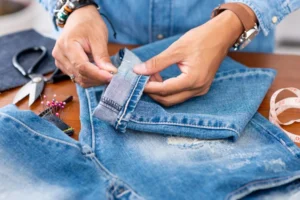Welcome to the exciting world of clothing upcycling, where your creativity meets sustainability! Upcycling clothes is not just a fun and fulfilling hobby; it’s a step towards a more eco-friendly lifestyle. By transforming old or unused garments into fresh, fashionable pieces, you not only give a new lease of life to your wardrobe but also contribute to reducing waste.

This journey, however, requires more than just enthusiasm. Having the right tools at your disposal is crucial for turning your vision into reality. In this guide, we’ll explore the essential tools that will help you embark on your upcycling adventure. From sewing machines to embellishments, each tool plays a pivotal role in ensuring your projects are not just successful, but also enjoyable.
Sewing Machine Essentials
A sewing machine is the cornerstone of any upcycling endeavor. It’s more than just a tool; it’s your partner in creativity, enabling you to stitch, alter, and embellish with precision and ease. For beginners, a basic model that handles fundamental stitches like straight and zigzag is a great start. However, as your upcycling adventures evolve, you may want to explore machines offering a wider array of stitches and functionalities such as embroidery or serging. The key is to choose a machine that aligns with your skill level and the complexity of your projects. It’s not just about the machine itself, but also about understanding its maintenance, like regular cleaning and needle changing, to ensure longevity and consistent performance.
Selection of Scissors and Shears
The right cutting tools can make a world of difference in upcycling. Scissors and shears are not a one-size-fits-all solution; each type serves a specific purpose. Fabric shears, with their longer blades, are ideal for making long, straight cuts, while smaller scissors are perfect for intricate work like trimming and clipping. It’s crucial to use tools specifically designed for fabrics to maintain precision and prevent damage to the material. Ergonomically designed handles and sharp, high-quality blades are key features to look for. Moreover, proper care, including regular sharpening and using them exclusively for fabrics, will keep them in top condition, ensuring clean and effortless cuts every time.
Tailor’s Chalk and Marking Pens
Tailor’s chalk and marking pens are unsung heroes in the upcycling process. These tools are pivotal for transferring patterns onto fabric or marking adjustments, ensuring that cuts and stitches are made precisely where they need to be. Tailor’s chalk comes in various forms, from traditional rectangles to more ergonomic shapes, and it’s known for its easy removal from fabrics. Marking pens, on the other hand, offer precision and can disappear with water or air. The choice between chalk and pens often depends on fabric type and personal preference. It’s important to test them on a scrap piece of fabric first to ensure they don’t leave permanent marks, especially when working with delicate or light-colored materials.
Choosing the Right Thread Types
Thread is the lifeline of any sewing project, holding everything together. When upcycling clothes, choosing the right thread is crucial. The thread needs to match not only in color but also in strength and elasticity to the fabric being used. Polyester thread is versatile and strong, making it suitable for a variety of fabrics, while cotton thread is perfect for sewing plant-based fabrics like cotton and linen. It’s also worth exploring specialty threads, such as heavy-duty or elastic threads for specific projects. Using the right thread ensures durability and enhances the garment’s overall appearance. It’s a small detail that makes a big difference, especially when stitching seams that need to hold together through wear and wash.
A Guide to Sewing Needles
Just as a painter selects brushes, a skilled upcycler knows the importance of choosing the right needle. Sewing needles come in various sizes and types, each designed for different fabrics and thread weights. Universal needles are a great starting point, but specialized needles like ballpoint (for knits) or jeans (for heavy fabrics) can significantly improve the sewing experience. The right needle glides through the fabric without damaging it, creating even stitches and preventing skipped stitches or fabric puckering. It’s also essential to change needles regularly – a dull needle can cause more harm than good. Understanding the nuances of needle selection can elevate your upcycling project, ensuring that each stitch is a step towards a beautifully finished product.
The Role of Irons and Steamers
Irons and steamers play a pivotal role in giving upcycled clothes a professionally finished look. These tools are used not just for removing wrinkles, but also for pressing seams, shaping fabric, and ensuring accurate measurements before cutting or sewing. A good steam iron can make a significant difference, especially when working with fabrics that are prone to creasing. The use of steamers is also on the rise, offering a quick and efficient way to smooth out garments, particularly useful for delicate or difficult-to-iron fabrics. It’s important to understand the heat settings suitable for different fabrics to avoid damage. Proper pressing techniques can enhance the overall appearance of the garment, making it look crisp, clean, and meticulously crafted.

Buttons, Zippers, and Embellishments
Accessories like buttons, zippers, and embellishments are the final touches that can transform an upcycled garment from ordinary to extraordinary. Buttons can be functional or purely decorative, adding a unique flair to a piece. The choice of buttons – from vintage styles to modern designs – can completely change the look of a garment. Similarly, zippers are not just closures; they can be a design element, adding a modern twist or a hidden functionality. Embellishments like lace, embroidery, or patches offer endless possibilities to personalize and add character to upcycled clothing. While selecting these accessories, it’s important to consider their compatibility with the fabric and overall design. These small details can significantly elevate the garment, reflecting the wearer’s style and the creator’s craftsmanship.
Conclusion
Embarking on your clothing upcycling journey is a wonderful way to unleash your creativity while making a positive impact on the environment. With the right set of tools, as outlined in this guide, you’re well-equipped to transform old clothes into unique and stylish garments. Remember, upcycling is not just about the end product; it’s about the process of reinventing and learning. As you progress, you’ll find that each tool becomes an extension of your creativity, helping you bring your imaginative designs to life. So, gather your tools, let your creativity flow, and enjoy the rewarding experience of giving new life to old clothes. Happy upcycling!
Frequently Asked Questions
Not necessarily. Basic sewing skills are sufficient to start with simple projects. As you gain confidence and experience, you can gradually tackle more complex designs.
Yes, you can certainly upcycle clothes without a sewing machine. Hand sewing, fabric glue, and other creative methods can be used, though a sewing machine does offer speed and precision for more intricate projects.
Inspiration for upcycling can be found everywhere – online platforms like Pinterest, Instagram, fashion blogs, or even local thrift stores can spark ideas. Additionally, joining upcycling communities or workshops can provide valuable insights and inspiration.



